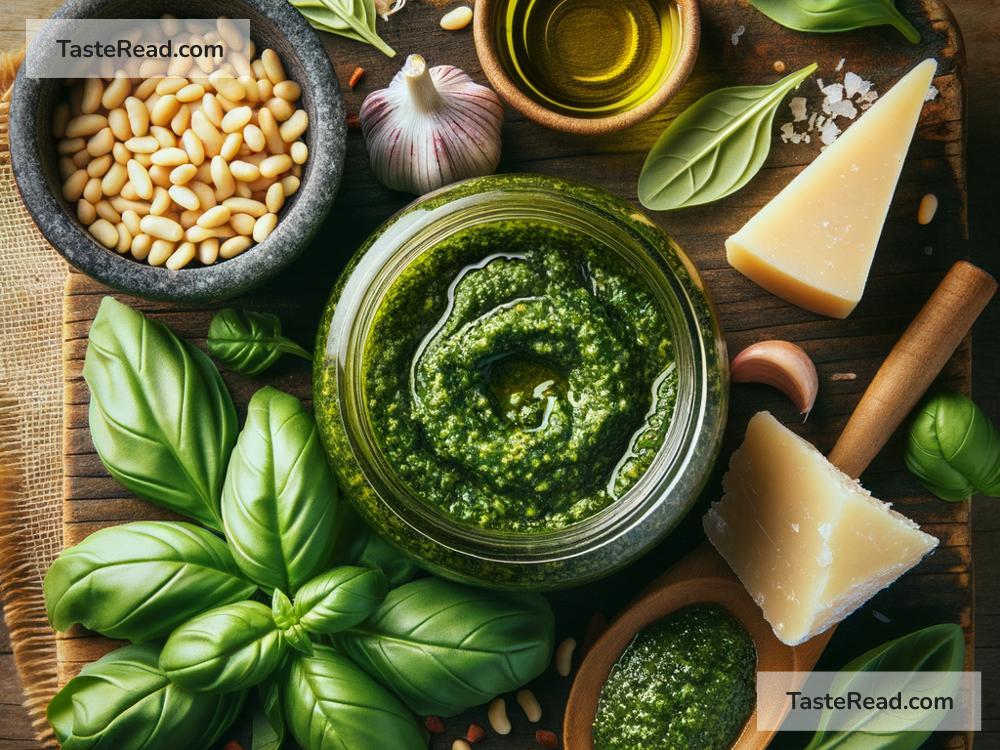How to Craft Homemade Pesto with Fresh Basil and Pine Nuts
Fresh, flavorful, and easy to make—homemade pesto is one of those magical sauces that turns simple dishes into truly delicious meals. Whether you drizzle it over pasta, spread it on sandwiches, or add it to soups, pesto packs a punch of taste and freshness. The best part about pesto is that you can make it at home in no time, using just a few simple ingredients.
In this blog, we’ll guide you step-by-step on how to craft homemade pesto with fresh basil and pine nuts. The beauty of this recipe is that it’s simple enough for beginners but yields a high-quality sauce that everyone will love. Let’s get started!
What Is Pesto?
Pesto is an Italian sauce traditionally made with fresh basil, olive oil, garlic, grated cheese, and pine nuts. While there are many variations, the classic recipe originates from the Liguria region of Italy. The word “pesto” comes from the Italian verb “pestare,” which means to crush or pound. Originally, pesto was made by hand using a mortar and pestle, but today, a food processor makes the job much quicker and easier.
Why Make Pesto at Home?
Store-bought pesto can be convenient, but making it at home allows you to control the ingredients, ensuring it tastes fresh and vibrant. Plus, homemade pesto often has a richer flavor compared to pre-packaged versions. You can also customize it to suit your preferences—add a touch more cheese, skip the garlic, or adjust the texture as you like.
Ingredients You’ll Need
For this recipe, you’ll need just six simple ingredients:
1. Fresh basil leaves – 2 cups (loosely packed)
2. Pine nuts – 1/4 cup
3. Garlic – 2 small cloves (peeled)
4. Parmesan cheese – 1/2 cup (grated)
5. Olive oil – 1/3 cup (extra-virgin is ideal)
6. Salt – 1/2 teaspoon (adjust to taste)
Step-by-Step Guide to Making Pesto
Here’s how to make fresh basil pesto at home:
Step 1: Gather Your Ingredients
Start by collecting all your ingredients. Having everything ready and measured in advance makes the process smoother. Wash the basil leaves gently and pat them dry with a paper towel.
Step 2: Toast the Pine Nuts
Toasting pine nuts adds a deeper flavor to your pesto. Place them in a dry skillet over medium heat and stir frequently for about 2-3 minutes or until they turn golden. Be careful not to burn them. Once toasted, set them aside to cool.
Step 3: Blend the Basil, Garlic, and Pine Nuts
In a food processor, combine the basil leaves, cooled pine nuts, and garlic cloves. Pulse a few times until the mixture is finely chopped but not fully blended.
Step 4: Add Cheese and Olive Oil
Next, add the grated Parmesan cheese to the food processor. While running the food processor, slowly pour in the olive oil. Blend until the pesto has a smooth and creamy consistency. If you prefer a chunkier texture, pulse it slowly instead of blending it completely.
Step 5: Season and Taste
Add the salt and any additional seasonings you like (such as black pepper or lemon juice). Taste the pesto and adjust to your preference. If it feels too thick, you can add a little more olive oil to thin it out.
How to Store Your Pesto
Homemade pesto tastes best fresh, but you can store it for later use. Transfer it to an airtight container and pour a thin layer of olive oil on top to prevent browning. Refrigerate for up to one week.
For longer storage, you can freeze pesto in ice cube trays. Once frozen, pop the pesto cubes into a resealable freezer bag. Frozen pesto can last for up to three months. Just thaw a cube whenever you need a burst of flavor in your dish!
Ideas for Using Pesto
Pesto isn’t just for pasta. Here are some creative ways to incorporate this delicious sauce into your meals:
– Toss it with roasted vegetables.
– Spread it on toast or crackers.
– Use it as a topping for grilled chicken or fish.
– Mix it into scrambled eggs.
– Add it as a pizza sauce base.
– Stir it into soups for extra flavor.
Tips for Success
- Use Fresh Ingredients: Fresh basil and good-quality olive oil make all the difference. Avoid packaged basil leaves—they won’t have the same vibrant flavor.
- Don’t Over-Blend: Over-blending can make pesto too smooth and dense. Pulse the mixture instead to keep some texture.
- Customize the Recipe: If pine nuts are hard to find or expensive, you can substitute them with walnuts, almonds, or even sunflower seeds.
Final Thoughts
Homemade pesto is one of those kitchen staples that’s easy to make yet adds a touch of gourmet elegance to your meals. Armed with fresh basil, flavorful pine nuts, and a few simple ingredients, you can whip up a sauce that’s rich, fragrant, and utterly delicious in no time.
Once you make it by hand, you might never go back to buying store-bought pesto again! It’s a versatile, affordable, and satisfying recipe that’s perfect for home cooks of all skill levels. Happy cooking!
What’s your favorite way to use pesto? Share your ideas in the comments below!


